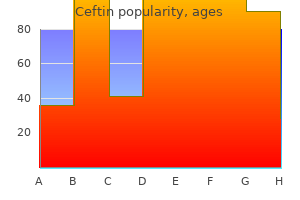

 5100 Springfield St. Suite 108, Dayton, Ohio 45431-1274
5100 Springfield St. Suite 108, Dayton, Ohio 45431-1274Ceftin
"Order 500mg ceftin, antibiotics zantac".
By: S. Muntasir, M.B. B.CH. B.A.O., Ph.D.
Co-Director, San Juan Bautista School of Medicine
Historically pcr antibiotic resistance generic 250 mg ceftin with visa, Eales disease Figure 7-51 Acute tuberculous uveitis with has been described as a peripheral retinal perivasculitis hypopyon bacteria h pylori symptoms cheap ceftin american express, posterior synechiae bacterial nanowires discount ceftin 500 mg, vitritis, retinal vasculitis, and CME. A periphlebitis is most commonly observed, which may be accompanied by venous occlusion, peripheral nonperfusion, neovascularization, and the eventual development of tractional retinal detachment (Fig 7-55). The association between TB and retinal vasculitis is supported by the identification by PCR-based assays of M tuberculosis DNA from the aqueous, vitreous, and epiretinal membranes of patients with Eales disease. Other posterior segment findings of TB include subretinal abscess, CNV, optic neuritis, and acute panophthalmitis. Diagnosis Definitive diagnosis of TB requires direct evidence of mycobacteria in bodily fluids or tissues. In many cases of ocular TB, this confirmation is not possible, and the diagnosis is instead presumptive, based on indirect evidence. A positive result on a PPD test or an interferon-gamma release assay is indicative of prior exposure to TB but not necessarily of active systemic infection. Uveitis affecting infants and individuals with HIV infection, those exposed to active children: infectious causes. An induration of 10 mm or Williams & Wilkins; 2005:277; courtesy of more is considered indicative of a positive result for Albert T. Patients with no known risks for tuberculosis are considered to exhibit a positive test result with an induration of 15 mm or more. False-negative skin testing results occur at a rate of 25% because of patients with profound acute illness or i m m u n e compromise, which can stem from corticosteroid use, advanced age, poor nutrition, and sarcoidosis. False-positive results may arise from patients infected with atypical mycobacteria, immunized with BCG vaccine, and treated with intraluminal BCG Figure 7-53 Fundus photograph of a choroidal injections for bladder carcinoma. Individuals recently tubercle with a macular star formation (miliary immunized with BCG vaccine may have an induration tuberculosis). A Bayesian analysis predicts that routine screening of uveitis patients for TB has a low probability of detecting disease in settings where the prevalence of TB is low. It is recommended, therefore, that testing be selectively used for patients in whom the index of suspicion has been heightened by a careful history, review of systems, and clinical examination. Testing for TB is of particular importance in patients being considered for treatment with tumor necrosis factor inhibitors. A history of recent exposure to TB or a positive TB test result warrants a concerted search for systemic infection, using chest radiography, positron emission tomography scanning, and/or microbiologic analysis of sputum, urine, or gastric aspirates, or a cervical lymph node biopsy for acid-fast bacilli. Failure to demonstrate systemic disease does not, however, exclude the possibility of intraocular infection. For cases of suspected ocular TB in which the results of the above-mentioned testing for systemic infection are negative, the patient is asymptomatic, or the infection is thought to be extrapulmonary, definitive diagnosis may require intraocular fluid analysis or tissue biopsy. Nucleic acid amplification techniques, with either transcription-mediated amplification of 16S ribosomal RNA or PCR amplification of unique DNA sequences of M tuberculosis, have been successfully used in some cases to diagnose intraocular TB, though the yield may be low because of a thick cell wall and possibly low bacterial load in the vitreous. Chorioretinal biopsy used i n conjunction with PCR testing and routine histologic examination may be necessary in atypical cases where the differential diagnosis and therapeutic options are widely divergent. Figure 7-54 Fundus photograph showing tuberculous choroiditis masquerading as atypical serpiginous-like choroiditis. The patient showed progression and recurrence while receiving immunomodulatory drugs; however, after antituberculous treatment was begun, the patient showed improvement in vision and resolution of the vitritis without recurrences. Multidrug therapy is angiogram showing diffuse late leakage from recommended because of the increasing incidence of peripheral retinal neovascularization. In the event of drug resistance, another drug, such as ethambutol or streptomycin, is added to the initial triple-drug regimen, followed by a 4-month continuation of INH and rifampin.

Although the eye may be the only location where the infection can be found antibiotic cipro order ceftin in india, there is an extraocular focus in 90% of cases bacteria 3162-roclis cheap 500 mg ceftin free shipping. Possible sources of infection to be considered are pneumonia antibiotic vs virus 250mg ceftin with mastercard, urinary tract infection, bacterial meningitis, or liver abscess. The most common gram-positive organisms are Streptococcus species (endocarditis), Staphylococcus aureus (cutaneous infections), and Bacillus species (from intravenous drug use). The most common gram-negative organisms are Neisseria meningitidis, Haemophilus influenzae, and enteric organisms such as Escherichia coli and Klebsiella species. In Asia, infection from Klebsiella species in liver abscesses is the most common cause of endogenous endophthalmitis. It is important to also consider endogenous endophthalmitis in newborns and infants, especially those younger than 6 months. The clinical features of endogenous bacterial endophthalmitis are suggestive of an ongoing systemic infection and may include fever greater than 101. Patients are often ill and being treated for a primary underlying disease when they present with endogenous endophthalmitis. The underlying disease may include cancer treated with prolonged intravenous chemotherapy as well as other chronic infections, which may subsequently sequester in the eye. A nonocular infection serving as a nidus for bacterial dissemination to the eye may be very difficult to diagnose, especially in cases of osteomyelitis, sinusitis, or pneumonia misdiagnosed as a simple upper respiratory tract infection. In these situations, laboratory tests cannot substitute for a detailed history and review of systems, which provide the most crucial information for making the clinical diagnosis in any uveitic condition. Examination usually reveals severely reduced visual acuity, periorbital and eyelid edema, and fibrin in the anterior chamber; hypopyon may be present (Fig 8-2). Small microabscesses in the retina or subretinal space and white, centered retinal hemorrhages (Roth spots) may also be present. Diagnosis is based on anterior chamber paracentesis and vitrectomy with vitreous and aqueous cultures and Gram and Giemsa stains if fungal organisms are suspected. As for cases of chronic postoperative endophthalmitis, PCR evaluation of ocular fluids with pan-bacterial or pan-fungal primers is extremely useful. Blood and other body fluid cultures should be used along with ocular culture results to confirm the diagnosis and establish therapy. Intravitreal antibiotics are administered at the time of vitrectomy; if it is not clear whether fungal organisms may be involved, treatment of both fungal and bacterial etiologies is Figure 8-2 Anterior chamber involvement with a "mass effect" from endogenous indicated at the time of vitrectomy. Similarly, in patients who have endogenous fungal endophthalmitis, systemic antifungal therapy may be warranted for 6 weeks or more. Initial antimicrobial choices may be empiric and may be tailored to culture results. If the diagnosis of systemic infection is missed, the patient may develop sepsis and even die. In severe cases, recurrent or persistent intraocular infection may require numerous surgeries and repeat injections of intravitreal antibiotics. In addition, complications such as cataract development, retinal detachment, suprachoroidal hemorrhage, vitreous hemorrhage, hypotony, and phthisis bulbi can occur in the most severe cases. The prognosis is directly related to the offending organism and the systemic status of the patient.

Certain conditions may cause apparent cupping of the optic nerve that can be confounded with glaucoma virus usb device not recognized discount ceftin 500mg, such as congenital pits of the optic nerve head bacteria 7th grade science ceftin 500mg lowest price, coloboma antibiotics for uti in humans cheap 500 mg ceftin overnight delivery, morning glory syndrome, arteritic ischemic neuropathy or compressive optic neuropathies. With rare exceptions, glaucoma results in increased cupping and pallor within the cup, but not pallor of the remaining rim tissue. The ophthalmologist must also consider drusen or coloboma as possible causes of optic nerve change and visual field loss. Finally, the myopic optic disc represents a challenge when the ophthalmologist is attempting to assess possible glaucomatous damage. The size, tilting, and associated structural changes often preclude the ability to definitively determine the presence of glaucomatous damage. Recording of optic nerve findings Due to the large variability in the appearance of the optic nerve head in healthy subjects, it is frequently not possible to confirm the presence of glaucomatous damage based on a single crosssectional observation. Therefore, glaucoma diagnosis frequently requires longitudinal monitoring and detection of progressive damage over time. Careful documentation is essential in order to allow adequate comparison of the optic nerve head appearance over time, both for diagnosis of the disease in individuals suspected of having glaucoma, and for detection of progression in those with established disease. It is common practice to grade an optic nerve head by comparing the diameter of the cup with the diameter of the disc. The diagram must be of adequate size to allow depiction of important topographic landmarks and morphologic features. However, even very well-detailed descriptions or drawings of the optic nerve head are generally insufficient to detect the subtle changes that may occur as the result of glaucomatous progression over time. Therefore, objective documentation of the appearance of the optic nerve head by photographs or imaging should be obtained whenever possible. Photography, particularly simultaneous stereophotography, is an excellent method for recording the appearance of the optic nerve for detailed examination and sequential follow-up. This record allows the examiner to compare the present status of the patient with the baseline status without resorting to memory or grading systems. If stereoscopic photographs are not available, even simple monoscopic photographs are preferable to drawings in documenting the appearance of the optic nerve head. However, evaluation of optic nerve head photographs is subjective and does not provide direct quantitative information about the degree of neural loss or rates of disease progression. Imaging of the optic nerve head and retinal nerve fiber layer Since the 1850s, the appearance of the optic nerve head has been recognized as critical in assessing the disease status of glaucoma. However, assessment of the optic nerve head at the slit-lamp or through photographs is subjective and shows relatively large interobserver and intraobserver variation. Imaging devices provide an objective means to obtain reproducible and highresolution images of ocular structures relevant to glaucoma. In addition, imaging devices contain normative databases that allow one to determine the probability that observed measurements are within the normal range, assisting in the differentiation of optic nerve damage from normal variation. Imaging assessment is also helpful for detecting progressive structural damage and for assessment of rates of disease progression. In recent years, increased attention has been directed toward the macular region for evaluation of glaucomatous damage. Confocal scanning laser ophthalmoscopy is another technology that can be used for assessing glaucomatous damage to the optic nerve head. The optical design of instruments using confocal scanning laser technology allows for a series of tomographic slices, or optical sections, of the structure being imaged.
A bacteria blood buy 500mg ceftin overnight delivery, Small choroidal melanoma with magnification bacteria during pregnancy generic 250mg ceftin fast delivery, Goldmann 3-mirror and newer wide-field orange pigmentation antimicrobial hand wash cheap ceftin online, abutting the optic nerve contact lenses can be used with the slit lamp, enabling a head. C, Mediumdetailed assessment of neurosensory retinal detachment, sized choroidal melanoma with exudative orange pigment, rupture of Bruch membrane, retinal retinal detachment. E, Mushroom-shaped Fundus photography is valuable for documenting the choroidal melanoma extending through Bruch appearance of choroidal melanoma and for identifying membrane. F, Amelanotic melanoma with changes in its shape and basal dimensions in follow-up invasion into the retina, surrounded by dark subretinal blood (asterisks). The relative positions of retinal blood vessels may be helpful markers of changes in the size of a lesion. Wide-angle fundus photographs allow clinicians to use intrinsic scales to measure the basal diameter of a choroidal melanoma. Fundus autofluorescence (FAF) imaging helps highlight orange pigment, which is brightly autofluorescent (Fig 17-8A, B). FAF is especially helpful in confirming the presence of orange pigment over amelanotic melanomas. In addition, any recent leakage of subretinal fluid produces increased autofluorescence (see Fig 17-8B), whereas long-standing or past leakage may result in decreased autofluorescence from secondary RPE atrophy. OCThis generally more accurate than ultrasonography when used for measuring and following changes in the thickness of choroidal lesions thinner than 1 mm, especially in the enhanced depth imaging (EDI) mode. OCThis also helpful in differential diagnosis because it can reveal degenerative RPE and photoreceptor changes in long-standing lesions, as well as orange pigment and subretinal fluid in suspicious pigmented lesions. Indocyanine green angiography is not more accurate for diagnosis, but it does often show alterations in choroidal blood flow in the region of the tumor. Wide-field angiography can also be used to assess vascular compromise after radiotherapy of choroidal melanomas. Ultrasonography is the most important ancillary tool for evaluating ciliary body and choroidal melanomas. The growth and regression of an intraocular tumor can be documented with serial examination. Standardized Ascan ultrasonography usually reveals a solid tumor pattern with high-amplitude initial echoes and lowamplitude internal reflections (low internal reflectivity; Fig 17-8C). B-scan examination provides information about the size (thickness and basal diameter), general shape, and position of intraocular Figure 17-8 Imaging of choroidal tumors. B-scan ultrasonography is the Choroidal melanoma with orange pigment (A) best technique for detection of posterior extrascleral that exhibits increased autofluorescence with fundus autofluorescence imaging (B). Note extension associated with intraocular malignancies (Fig also increased autofluorescence associated 17-8F). Occasionally, tumor shape and associated with recent leakage (subretinal fluid) inferior to retinal detachment can be evaluated more easily with the tumor. B-scan ultrasonography is used primarily to show the choroidal mass that has a highly reflective anterior tumor location and its topography. Posterior extrascleral which does not share these limitations, enables excellent extension of tumor (between arrows) is apparent as a low-reflective orbital lesion in imaging of the anterior segment and ciliary body (see contact with the sclera (F). Although CT and MRI are not widely used to assess uncomplicated intraocular melanocytic tumors, they are useful in identifying tumors in eyes with opaque media and in determining extrascleral extension and involvement of other organs.
Generic 250mg ceftin otc. Fighting Antibiotic Resistance: Fan Liu.
